|
|
Two summers ago, at the first Fiber Festival in Crystal Lake, I took a workshop in weaving on one of those tiny little square looms. It was fun and entertaining, but of course anything that small is really only useful for sampling (since I’m not about to make a bunch of small squares to sew together).
Soon after I happened to be at a yarn shop in Richmond, and somehow this came up.  The store owner persuaded me to purchase an Easy Weaver loom, which proceeded to sit in its box, unopened, until a few weeks ago.
I finally pulled it up and set it up – it comes pre-warped, in this case in a tartan warp pattern in 2 ply wool.  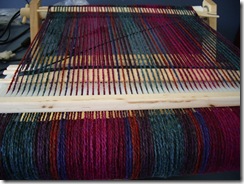    Â
It’s a simplified Rigid Heddle loom, with I think a maximum width of 13â€.  On it I wove two scarves, each about 50†in length, using the provided red and green yarn.  For the first I used their suggested 3/3/10/3/3 pattern and when I was through the fringe was done with a simple overhand knot:
 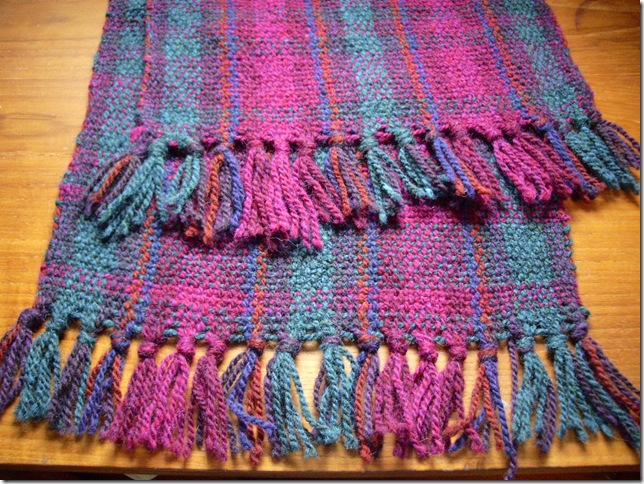 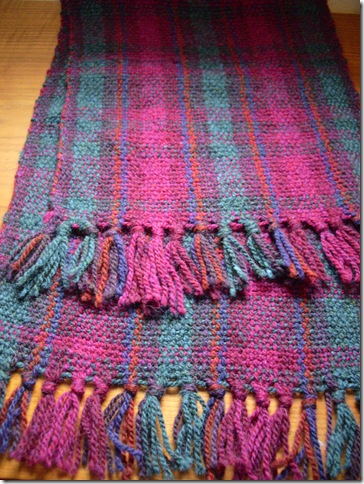
Â
When I finished the first scarf, it remained on the loom – I left space for a fringe, wove a 6 row ‘header’, left another space for fringe, and resumed weaving.  The second was also about 50†with the same weft, but this time I wove a 3/5/8/5/3 pattern and braided the fringe.
 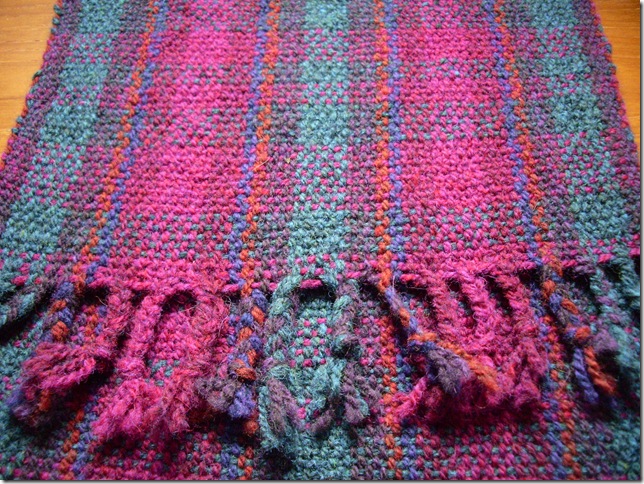 
It was an interesting exercise and I think I learned a lot about how it works, and my likes/dislikes . Weaving is fast! I was able to find and correct some errors while weaving, others are still there.  At first I was cutting the yarn at each change, but of course that meant ends to weave in – so I quickly figured out how to carry the yarn along the selvedge, which I liked much better.  My selvedges are a bit uneven, but not as bad as I feared – I think they evened out a bit in the wash.  The warp shows much more than I would have guessed.    I like the 3/5/8 pattern better than the 3/3/10 one, but I prefer the loose fringe to the braided. I made the mistake of washing the entire fabric in one piece right after pulling it off the loom – I should have cut it and tied the fringes, and fixed any errors, first, as they weren’t particularly correctable after.
Â
I liked that the loom came pre-warped, as it let me weave first and leave learning warping for later. It was frustrating though to find multiple knots in the warp, as well as one break. Unlike a more-typical RH loom, the Easy Weaver uses velcro to hold the warp ends on the front and back beams.  That does seem to give less loom waste (though there certainly was some!) and struck me as rather clever.  Still, as I am reading a book about basic weaving, I can already see why this is considered an ‘educational toy’ (something that escaped me when I purchased it, unfortunately) — it has heddles of course, and a shed and shuttles, but no dents nor treadles.  For learning the basics and deciding if I like weaving at all, it is fine – but as I could have purchased a more complex/complete rigid heddle loom for not a lot more, I’m a bit sorry I hadn’t done some research first.  Still and all – I think I would like to take some classes using different types of looms before I consider an additional or replacement loom – it’s apparent that the difference in loom types is considerably more meaningful in terms of what you can do than I have thus far found with spinning wheels!
Sunday we made a chicken dish that came out pretty well, and so I’m sharing the recipe here.
Ingredients per original recipe:
- Artichokes – 2 8oz cans
- Mushrooms – 1lb
- Chicken – 5 breasts, cut in half
- 1.5 cups chicken broth
- 1/2 cup cream
- 1/2 cup milk
- 1/4 cup sherry
- 3 TB butter
- 4 TB flour
- Bread crumbs
- Parmesan Cheese, grated or shredded
What I actually did:
Firstly, butter or oil a casserole dish (8×12) – I used olive oil.
I had no mushrooms, but I did have a huge jar of artichokes, so I simply made a layer of artichokes on the bottom of the dish, making no attempt to measure it.
Precook the chicken in sherry – I had a whole deboned chicken, and I essentially sautéed it in sherry until the outside was cooked, but made no effort to cook it all the way through. Could have stood to do another chicken, ended up with a lot of liquid relative to chicken.
Layer the chicken in the pan on top of the artichokes
Add to the sherry: broth, cream, milk, salt & pepper to taste, and butter, and bring to boil. I added a little more sherry at this point because I used it to rinse the rest of the cream and milk from the measuring cup. Feel free to vary proportions to taste. Whisk in the flour a tablespoon at a time to thicken the sauce, but you want sauce, not gravy, so not too much!
Pour liquid over the chicken and artichokes. Add a layer of breadcrumbs (I used unseasoned panko ones, didn’t want warring seasonings) and a layer of parmesan cheese. Bake the whole thing at 350 for 30 minutes and server over rice.
We made the rice in the chicken broth from the last local chicken, and promptly turned the bones from this one into, you guessed it, more broth! It’s a virtuous cycle, or something.
After I spun the Merino, I picked up another colorway from Spunky Eclectic — this time a sliver of Coopworth in the colorway Nightshade.  While the fiber itself was perhaps a bit coarse and scratchy, I love the colorway and am sad she isn’t still producing it.
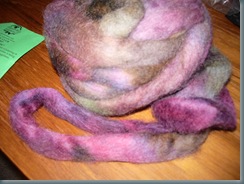 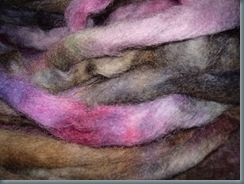
For this I went back to my default spinning — short-forward draw/inch-worm style, a relatively fine 2-ply.    Since there wasn’t a discernible pattern to the colors (it looked kettle-dyed rather than space-dyed), instead of splitting the entire roving lengthwise, I opted to fold it in half, and literally split across the middle of the length.  My hope was that I would get reasonably close to the same lengths on the two bobbins (though that didn’t occur) but I wasn’t trying for a consistent color. I packed both bobbins pretty full.
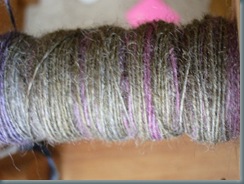 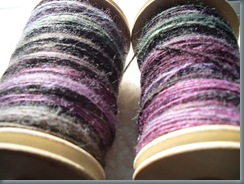
Since I was spinning finer, and often in short bursts, it was about 10-12 days from start to finish. I overfilled the first plied bobbin, continuing to ply until it refused to wind-on. The remainder was plied normally until one of the bobbins was finished, and than I opted to chain-single ply the last of it.  I find plying from a center pull ball to be difficult with fine singles, as it likes to collapse and tangle. Unfortunately, my skill with chain-singles isn’t that much better, plus it frankly is not as strong a yarn due to being a ‘fake 3ply’. Still, it has the advantage of preserving the colors in the singles, so I enjoy doing it with the leftovers — I figure they can be used for an edging on whatever I end up making, as the resulting yarn is obviously related, yet not really the same color look as the 2ply
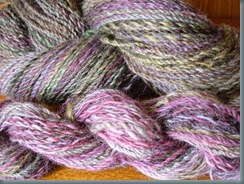
The 2-ply is in the top in the above picture, and the left-hand picture below.  I’m especially happy with the main skein — it softened up considerably in the wash, and it looks really good.  The quasi-3ply isn’t especially even in my opinion, but I do like the appearance and am basically satisfied with it.
 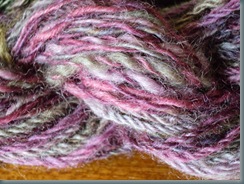
I enjoyed spinning this — even it did have more matted places than I’ve ever encountered in one of Amy’s fibers before. It also bled like crazy — I always had bluish/purple fingers while spinning and plying, and a good bit of blue dye went down the sink (I tried adding vinegar to the wash water, but I doubt it helped). I am assuming that both were a side effect of the much-darker than usual colorway. Regardless, I would definitely spin this again!
After I finished the previous batts I was still in the mood for fast spinning, so last weekend I spun up some Merino roving I had from Spunky Eclectic, in the colorway Mudslide. Merino is a very soft fiber that really is best served by being spun thick and lofty anyway. Again, being from a fiber club, this happened to be a colorway I wasn’t especially keen on.
Now, her fiber is carded and in roving form; this particular one was space-dyed, and had a distinct pattern.   I unrolled the braid, and then stripped it – here is one of the strips (I forgot to take a photo prior to stripping and unfortunately this is the only one I took of the strips): 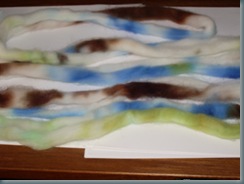
I designated one end ‘A’ and the other ‘B’ and spun it up A-B, then B-A, then A-B etc.   Since I had 4 oz, and my bobbins hold about 2oz, I simply spun until the bobbin was full, making sure though that I finished the strip.  I then spun the second bobbin the same way, and plied them as-is.  If I was really being anal about getting the colors to line up for striping rather then barber pole, I had a couple choices. Firstly — I could simply have chain-plied — but that is a ‘fake’ 3-ply that isn’t as structurally sound and I’m not that good at it anyway.
For the two-ply I wanted I could instead have measured the fiber out by weight prior to stripping to ensure even division, and then been exceedingly careful about making each strip the same size, or pre-drafted each to the identical dimensions and then spun without further drafting.  Truly anal people than go so far as to break their single while plying when the color lengths don’t line up.  I am not this anal, and did none of this.
Here is the first bobbin-full, with the 2nd half of the fiber waiting to be stripped and spun, and the first skein.
 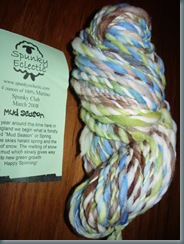
When plying I really filled up the bobbin because I only wanted to end up with two skeins (I could use a large plying flyer/ bobbin setup if this is going to become a habit!).  I was stunned at how much the plied yarn puffed out versus even the singles, and how noticeably so just on the bobbins. I really overloaded them.    I washed (carefully!) in hot soapy water, let cool to lukewarm, and rinsed and hung to dry unweighted.  I was very carefully not to agitate or shock, as Merino has a reputation for felting if you look at it funny. I ended up with two very soft and squishy skeins! Quite nice really, though there are a few sections where both singles were a bit under spun at the same time.
Ready for my close-up!
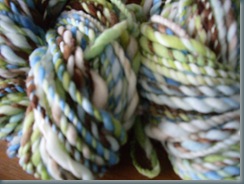 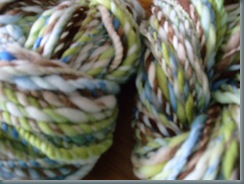
After taking a silk spinning class, which I wasn’t very good at, I started practicing. Since I was focused on silk, which wants to be spun thin and high twist (well, it just looks better that way!) my ‘default’ yarn size got rather thin over time. Since I’m not exactly the fastest spinner around, it could take me an exceedingly long time to work my way through 4 oz of fiber when spinning dk or lace weight. A couple of weeks ago I wanted to spin, but wanted more-immediate gratification than thin spinning allows. So, I dug through my fiber supply and pulled out a crosspatch creations batt that, while nice, wasn’t a colorway I particularly cared for, and made an effort to spin it thick and soft. This was harder than I expected (though it did get easier once it dawned on me to adjust my wheel from the smallest to largest whorl :p) — I definitely spun a bit thick-and-thin! Still, I filled 3 bobbins, and made a very soft and squishy 3-ply that is really quite soft and nice. It’s very textural (as are their batts), and being carded rather combed there was a lot of VM to pick out — also, this particular batt was still high in lanolin — nice feel, but made it a bit sticky.
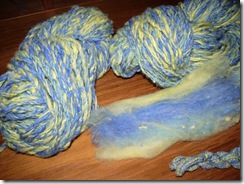
This shows the batt, the original sample skein (tightly spun and plied) and my rather loosely spun 3ply. Crosspatch Creations are known for being very textured batts (lots of silk noil)
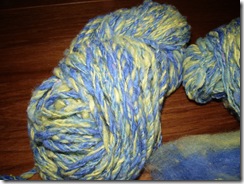
This is a close-up of one of the skeins. You can see how thick and thin it ended up. Still, it IS really soft. And while the blue and yellow combo do nothing for me, I think it is a perfectly usable yarn. Having finished that, but still in the mood for a fast spin, last night I pulled out a Spunky Eclectic roving that was again a colorway I wasn’t overly fond of. This turned out to be merino, a fiber I hadn’t spun before. I had forgotten just how *nice* her rovings are prep-wise. Still fairly fluffy, and completely clean. I stripped it repeatedly to open it up a bit, and I’m spinning the strips A-B, B-A, A-B… I filled a full bobbin last night, and I’m pretty happy with it over all. Still a bit thick and thin, but more consistent this time, and I think it’s going to be quite soft (which, with Merino, is rather the point). This time I’ll go 2-ply I think. I find that I prefer the ‘look’ of a thin, tightly spun, tightly plied yarn, but the ‘feel’ of a loosely spun, loosely plied yarn. A conundrum.
Over the years I’ve been attempting to eat more local foods. Initially, I simply joined a summer CSA — vegetables, fruit, and flowers on a weekly basis. The next year I joined the same CSA again, but for the entire 3 seasons — April through early December.
Pluses:
- We ate better — considerably more produce than we would have purchased on our own.
- It was fresher, and I really like knowing where my food is from — I like meeting the farmers, I like knowing it is organic, and where it is grown.
- I discovered that my dislike of salads was due to the traditional iceburg lettuce — spring greens on the other hand, make a great salad.
- Garlic scapes make good garlic butter
- I learned that turnip greens cooked southern style are quite good, and young turnips blend just fine with potatoes in soup.
- Many greens can be steamed and frozen for later, and spinach (or chard, or…..) makes a wonderful addition to my breakfast casserole.
- I may not like blueberries plain, but they are yummy in a warm muffin so that they are all soft and melty
- Fennel bulb is surprisingly tasty — and I now have a great recipe for a fennel, italian sausage, and swiss cheese entree!
- Fresh peaches make a great cobbler
- There’s nothing quite like local-grown just-picked corn (not organic), grilled.
- There’s no such thing as too many sweet cherries, or blackberries.
- A weekly bag of seasonal produce results in learning to use new items.
Negatives:
- A full brown grocery bag of produce each week is too much for just two people who aren’t vegetarian, leading to waste
- We got a lot of items that one of us either wouldn’t (rasberries, rutabagas) or couldn’t (sage, bell peppers) eat – see waste
- Some things we never could figure out what to do with — kohlrabi for instance.
- Many local/seasonal items are time-consuming and complicated to prepare, not a plus for a working couple (beets!)
- Finding a CSA with times/places for pickup that works out is not necessarily easy.
While in general the pluses outweighed the negatives, the amount of wastage (and not having a convenient pickup) meant we didn’t do a CSA the last couple of years. This year I’m trying again — I found a vegetable CSA that is every-other week, with Sat afternoon pickups nearby and we’re doing the original fruit share again — that’s weekly on Thursdays, but back to being on Mike’s way home, and only for the summer. I’m hopeful that a half-share of produce will be easier to manage, while still meeting all the pluses! As we did last year, we’ll supplement with farmers markets, now that we know where a few different ones are.
|
|
 Â Â
  

















Recent Comments